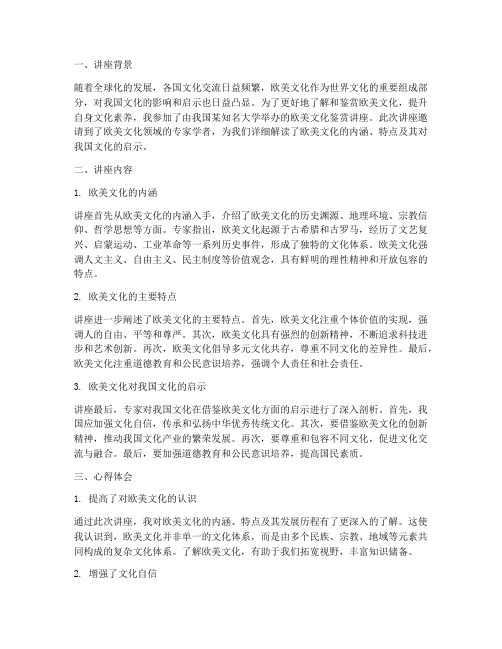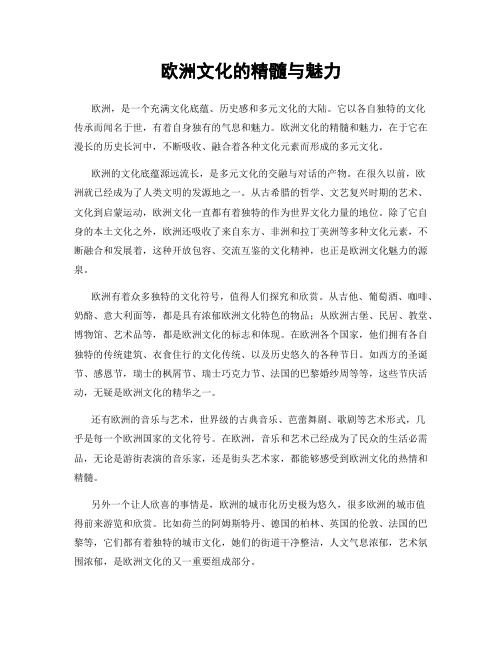欧洲文化鉴赏
欧洲的历史文化

欧洲的历史文化欧洲是一个历史悠久、文化繁荣的大陆。
在过去的几千年里,欧洲大陆经历了许多重要的历史事件和文化发展,留下了丰富多样的历史遗产和文化传统。
本文将以时代为线索,介绍欧洲的历史文化。
古典文明时期古希腊和古罗马文明是欧洲历史上最为重要的两个文明之一。
古希腊文明以其哲学、艺术和政治思想的繁荣而闻名。
众所周知,古希腊是民主政治的起源地,也是西方文明的发源地之一。
古希腊的艺术作品体现了对人体和自然的完美追求,如帕台农神庙和米洛的维纳斯雕像。
古罗马文明是古代欧洲最宏大、最有影响力的文明之一。
罗马帝国的法律体系和行政制度对后来的欧洲国家产生了深远的影响。
古罗马的建筑物也是古典文明的杰作,如罗马斗兽场和斯帕尼什广场。
中世纪与宗教艺术中世纪是欧洲历史上一个重要的阶段,以封建制度和基督教信仰的传播为特征。
这个时期的文化受到宗教的强烈影响,教堂和修道院成为文化艺术的中心。
哥特式建筑是中世纪欧洲最重要的建筑风格之一,以其尖塔和飞扶壁而闻名。
巴黎圣母院和英国威斯敏斯特大教堂都是哥特式建筑的典范。
文艺复兴时期文艺复兴时期是欧洲历史上文化艺术的鼎盛时期。
在这个时期,古罗马和古希腊的文化遗产再次受到重视和推崇。
人们开始重拾古典文化,并对艺术和科学进行了深入研究。
达芬奇、米开朗琪罗、拉斐尔等艺术家在绘画和雕塑方面做出了革命性的贡献。
意大利的佛罗伦萨成为文艺复兴时期最重要的艺术中心之一。
启蒙运动时期启蒙运动是欧洲历史上一场思想解放和文化革命的运动。
在这个时期,人们开始对传统观念进行批判,强调理性、科学和人权。
法国启蒙思想家伏尔泰、英国哲学家洛克等人对欧洲的政治和社会发展产生了深远影响。
音乐家巴赫和莫扎特则是这一时期音乐界的代表人物。
现代欧洲现代欧洲是一个多元化的文化大陆,各国之间有着独特的历史和文化传统。
英国的莎士比亚和德国的歌德是欧洲文学史上的巨擘,他们的作品影响了世界各地的文学创作。
法国的印象派和荷兰的后印象派则对绘画艺术有着深远的影响。
欧洲企业文化特点

欧洲企业文化特点1.多元化和包容性:欧洲地区由各种不同国家和文化组成,企业文化也反映了这种多元化和包容性。
欧洲企业通常鼓励员工来自不同的背景和文化,欢迎多元化的观点和经验。
他们鼓励员工相互尊重和合作,并重视团队合作的重要性。
2.平等和公正:欧洲企业文化重视平等和公正的原则。
在欧洲的职场环境中,雇主倾向于平等对待所有员工,无论其性别、种族、宗教或国籍如何。
他们鼓励员工以公正和正直的方式行事,并提供平等的机会和待遇。
3.工作与生活的平衡:欧洲企业文化非常注重员工的工作与生活的平衡。
欧洲员工有更长的带薪假期,更短的工作时间和更多的家庭支持政策。
企业鼓励员工有充足的休息和休假时间,并保持健康的工作和生活平衡。
4.长期稳定性:相比其他地区,欧洲企业更注重长期稳定性和可持续性。
他们通常更加关注长远的目标和战略,而不仅仅是追求短期利益。
欧洲企业更倾向于进行深思熟虑的决策,并将长远利益放在首位。
5.创新和可持续发展:欧洲企业文化强调创新和可持续发展。
欧洲企业倾向于采用环保的商业模式,并更加关注企业的社会责任。
他们鼓励员工提出新的想法和方法,并致力于提供可持续的解决方案。
6.高度专业化:欧洲企业文化注重专业化和专业技能。
欧洲的教育系统培养了很多高素质的专业人才,企业重视员工的专业能力和技术水平。
欧洲企业鼓励员工继续学习和发展自己的技能,以满足日益变化的市场需求。
7.开放和透明:欧洲企业文化强调开放和透明的沟通。
决策往往是合作和共识的结果,而非由少数决策者做出。
欧洲企业倡导开放的企业文化,鼓励员工提供意见和建议,并为公司的决策过程提供透明性。
总体而言,欧洲企业文化注重多元化、包容性、平等、公正、工作与生活的平衡、长期稳定、创新、可持续发展、专业化、开放和透明等特点。
这些特点反映了欧洲企业在经营管理中的价值观和优先考虑的因素。
欧洲的主要民族与地域文化特点

欧洲的主要民族与地域文化特点欧洲是一个地域广阔、多民族共存的大陆。
在这片土地上,各个国家和地区拥有独特的民族和地域文化特点。
本文将对欧洲的主要民族和地域文化进行介绍。
一、西欧地区1. 法国:法国是一个多元文化的国家,其中最著名的有法国人和布列塔尼人。
法国人文化以浪漫主义和艺术为特色,拥有丰富的文化遗产、美食和时尚。
2. 英国:英国是由英格兰、苏格兰、威尔士和北爱尔兰四个国家组成的联合王国。
英国文化深深影响着世界,包括莎士比亚的戏剧作品、摇滚乐和英式下午茶等。
3. 德国:德国是欧洲最大的国家之一,人口众多。
德国人民崇尚严谨和效率,德国文化有着悠久的历史,例如哥特式建筑、古典音乐和啤酒节等。
二、中欧地区1. 意大利:意大利是艺术和文化的发源地之一,以罗马、佛罗伦萨和威尼斯等城市而闻名。
意大利人民对时尚、美食和家庭价值观有着独特的追求。
2. 西班牙:西班牙是一个热情洋溢的国家,拥有多元文化和宗教。
西班牙人以弗拉明戈舞、托雷阿多斯和圣诞节等传统活动而闻名。
3. 波兰:波兰是一个历史悠久、宗教信仰深厚的国家。
波兰人尊重传统价值观,重视家庭和宗教,波兰复活节和圣诞节是他们最重要的节日。
三、东欧地区1. 俄罗斯:俄罗斯是欧洲最大的国家,人口众多。
俄罗斯文化深受东正教影响,以独特的建筑风格、音乐和文学作品而闻名。
2. 瑞典:瑞典是一个寒冷的北欧国家,素有"北欧之花"的美誉。
瑞典人尊重平等和个人自由,崇尚简约而精致的设计风格。
3. 希腊:希腊是古代文明的发源地之一,希腊人民对民主和艺术有着深厚的传统。
希腊文化以古典建筑、神话传说和奥运会等闻名于世。
四、北欧地区1. 芬兰:芬兰是北欧最大的国家之一,拥有独特的北欧民族文化。
芬兰人尊重自然和环境,热衷于桑拿和户外活动。
2. 挪威:挪威是一个富有石油资源的国家,素有"峡湾之国"的美誉。
挪威人注重社会福利和平等,他们享受户外活动和北极光的美景。
中世纪欧洲的科技与文化

中世纪欧洲的科技与文化中世纪欧洲是一个充满着神秘和浪漫的时期,同时也是欧洲历史上非常重要的一个时期。
在这个时期,科技和文化都经历了很多的变革,给人们的生活带来了很多的变化。
本文将介绍中世纪欧洲的科技与文化。
1. 中世纪欧洲的科技在中世纪欧洲,科技发展并不是很快,但也不能说没有进步。
在那个时期,欧洲各地都涌现了很多有创新精神的人。
他们不断地探索、研究和发明,从而促进科技的不断进步。
1.1 印刷术印刷术的发明是中世纪欧洲最重要的一项科技成就之一。
在15世纪初期,德国的约翰·古腾堡首先发明了可移动活字印刷术,从而使书籍的印刷变得更加容易和快捷。
印刷术的发明,不仅促进了知识的传播,也使读书人能够迅速地获取知识。
由于印刷术的发明,很多新的思想和理论也得以传播,对欧洲文化的发展产生了重大影响。
1.2 建筑中世纪欧洲的建筑技术也得到了一定程度的发展。
在这个时期,大教堂和城堡都是欧洲最显著的建筑。
由于这些建筑主要是由石头组成,因此需要相当高的技术来建造。
建筑师和工匠们发明了许多新的技术来解决建筑和设计问题。
例如,他们发明了几何技术,可以使建筑物更加美观和稳定。
1.3 等离子技术等离子技术是一种现代科技,但是它的历史可以追溯到中世纪欧洲。
在那个时期,人们已经知道了许多显示等离子的现象。
富有创新精神的人,如威廉·吉尔伯特和特奥弗拉斯托斯·冯·鸠尔纳发明了一些实验用具来研究等离子。
这些实验让人们更加了解电学理论,促进了电学科学的发展。
2. 中世纪欧洲的文化中世纪欧洲的文化历史也非常丰富多彩,涌现出了很多让人惊叹的文化成就。
下面将介绍中世纪欧洲的几个重要的文化领域。
2.1 文学中世纪欧洲的文学受到罗马时期文学的很大影响。
在这个时期,人们主要是通过口头传说来进行文学创作。
在英国,人们创作了《贝奥武夫》,这是一部叙事诗,也是英国文学的经典之作。
法国的诗歌《鲁兰之歌》也是中世纪欧洲文学的代表作之一。
欧洲简短文化风情

欧洲简短文化风情1.法国的民俗风情(简略)法国民俗风情交际习俗注重服饰的华丽和式样的更新。
妇女视化妆和美容为生活之必需。
时间观念强,工作计划性强,奉行“女士第一”的原则。
习惯行握手礼,有一定社会身份的人施吻手礼。
少女常施屈膝礼。
男女之间,女子之间及男子之间,还有亲吻面颊的习惯。
社交中不愿他人过问个人私事。
反感向妇女赠送香水及初次见面就送礼。
信仰禁忌大多信仰天主教。
忌“13”和“星期五”。
忌黄色和墨绿色。
忌孔雀和仙鹤。
视菊花、杜鹃花与核桃等为不祥之物。
喜爱艺术和娱乐活动。
饮食特点法国人会吃,也讲究吃。
法国菜风靡世界。
法国人喜欢吃蜗牛和青蛙腿,最名贵的菜是鹅肝。
喜欢喝酒。
法国菜的特点是鲜嫩。
法国人也非常喜欢中国菜。
服饰法国时装在世界上享有盛誉,选料丰富、优异,设计大胆,制作技术高超,使法国时装一直引导世界时装潮流。
在巴黎有2000家时装店,老板们的口号是:“时装不卖第二件”。
而在大街上,几乎看不到两个妇女穿着一模一样的服装。
目前高级时装最有名的有:“吉莱热”、“巴朗夏卡”、“吉旺熙”、“夏奈尔”、“狄奥尔”、“卡丹”和圣洛朗”。
近年来,特别引人注目的是巴黎女郎的裙子,其式样之多。
款式之新,在别国很难见到。
法国人是把收入的最小部分用于穿着的欧洲国家,法国人一般很注意服装方面的鉴赏力,也接受比较便宜的而不十分讲究的仿制品。
小动物当今法国家庭,对小动物恩宠倍加,不惜耗费巨金收买哺养。
有一半以上家庭饲养各种小动物,总头数在3000万只以上。
1/3的家庭养狗,狗的数量已近4万条。
各种狗医院、狗服装店屡见不鲜。
动物不仅给法国人带来了乐趣,也造成一定灾难。
法国每年发生狗伤人的事件50多万起。
礼仪法国是一个讲文明礼貌的国家。
对妇女谦恭礼貌是法国人引以自豪的传统。
法国人见面打招呼,最常见的方式莫过于握手。
不过握手时一是握时间不应过长,二是没有必要握住人家的手使劲晃动。
一般是女子向男子先伸手,年长者向年幼者先伸手。
上级向下级先伸手。
深入了解欧洲文化的十个要点

深入了解欧洲文化的十个要点欧洲作为一个拥有悠久历史和独特文化的大陆,吸引着无数人的眼球。
要真正理解和欣赏欧洲文化,我们需要对其深入了解。
本文将介绍深入了解欧洲文化的十个要点,帮助读者更好地把握欧洲的独特魅力。
1. 多样性和融合:欧洲是一个多民族、多文化的大陆。
不同国家和地区拥有自己独特的语言、风俗和传统。
然而,欧洲文化也强调融合和共同价值观。
例如,欧洲联盟的形成就是为了加强欧洲国家的团结和合作。
2. 历史遗产:欧洲是历史上许多伟大帝国和文明的发源地。
从古希腊罗马文明到中世纪君主制,欧洲的历史遗迹无处不在。
游览欧洲的古迹和博物馆,能够感受到沉浸在历史中的激动和敬畏。
3. 艺术与文学:欧洲文化以其卓越的艺术和文学成就而闻名。
莎士比亚、达·芬奇、莫扎特等众多欧洲艺术家和作家的作品至今仍然影响着世界。
欧洲也是许多重要艺术运动的发源地,如文艺复兴和印象派。
4. 音乐和舞蹈:欧洲有丰富多样的音乐和舞蹈传统。
古典音乐在欧洲尤其盛行,德国的贝多芬和奥地利的莫扎特等作曲家的音乐作品被奉为经典。
此外,欧洲也是许多著名芭蕾舞团和舞蹈学院的发源地。
5. 美食与饮食文化:欧洲各国拥有丰富的美食文化,每个国家都有其独特的传统菜肴和烹饪方式。
法国的蜗牛、意大利的比萨和西班牙的火腿都成为了国际上著名的美食代表。
欧洲餐桌上的用餐仪式和礼仪也是一种独特的文化体现。
6. 时尚与设计:欧洲在时尚和设计领域具有重要影响力。
伦敦、米兰和巴黎等城市是世界时尚之都,吸引着无数时尚爱好者和设计师。
欧洲的时尚产业和设计风格独特而多样,带来了许多令人眼花缭乱的创意。
7. 社交和礼仪:欧洲人注重社交礼仪,尤其是在商务和正式场合。
例如,英国人的绅士风度和法国人的细致考究都是欧洲社交礼仪的体现。
了解欧洲社交规则和礼仪可以帮助在欧洲社交场合中更好地融入和交流。
8. 节日和庆典:欧洲的各个国家和地区都有丰富多样的节日和庆典。
例如,德国的啤酒节、意大利的威尼斯狂欢节和西班牙的斗牛节等,都吸引着全球的游客。
欧洲的民俗与节庆文化

欧洲的民俗与节庆文化欧洲是一个历史悠久、文化多样的大陆,拥有丰富多彩的民俗与节庆文化。
这些民俗与节庆活动承载着欧洲各国人民的传统、价值观和信仰,成为他们生活中不可或缺的一部分。
本文将带领您探索欧洲的民俗与节庆文化,展现其独特之处以及对人们生活的重要影响。
一、圣诞节(Christmas)圣诞节是欧洲最重要、最盛大的节庆之一。
在欧洲的许多国家,人们为庆祝耶稣降生而举行各种仪式和活动。
城市和村庄张灯结彩,街头巷尾充满了节日的氛围。
人们会亲友团聚,一起享受美味的圣诞大餐和传统的糖果。
而圣诞老人的形象也是不可或缺的,他会在圣诞夜里给孩子们送上礼物。
二、复活节(Easter)复活节是欧洲另一个重要的节日,它庆祝耶稣复活的日子。
复活节的庆祝活动包括宗教仪式、彩蛋制作和寻找彩蛋的游戏等。
彩蛋是复活节的象征,人们会用各种色彩绚丽的颜料将鸡蛋涂成各种花样,然后将彩蛋藏在花园里,孩子们在园子里寻找这些彩蛋,这也成为了一项传统的游戏。
三、狂欢节(Carnival)狂欢节是欧洲最具盛名的节庆之一,以意大利的威尼斯狂欢节最为著名。
在这个节日里,人们身着华丽的面具和服装,参加游行和舞会,尽情享受快乐和放纵。
花车巡游、烟火表演和面具舞会是狂欢节的主要活动,狂欢节带给人们无尽的欢乐和娱乐。
四、圣帕特里克节(St. Patrick's Day)圣帕特里克节是爱尔兰人民的传统节日,也在欧洲其他地区庆祝。
这个节日是为了纪念爱尔兰的守护神圣帕特里克而设立的。
人们会身穿绿色服装,戴上绿色帽子,参加各种游行和庆祝活动。
在这一天,绿色的装饰和象征爱尔兰的三叶草随处可见。
五、十一月一日(All Saints' Day)十一月一日是欧洲许多国家的宗教节日,用来纪念所有去世的圣徒。
人们会前往教堂祈祷,悼念逝去的亲人和朋友。
此外,在法国和西班牙等地,人们还会前往墓地,为已故的亲人献上鲜花和蜡烛。
六、德国啤酒节(Oktoberfest)德国啤酒节是世界上最大的规模庆祝活动之一。
欧洲中世纪的与文化

欧洲中世纪的与文化欧洲中世纪的文化中世纪是欧洲历史上一个重要的阶段,这个时期从公元5世纪持续到15世纪,涵盖了许多重要的文化、政治和经济变革。
欧洲中世纪的文化是这个时期的重要部分,对后来的艺术、哲学和思想产生了深远影响。
本文将探讨欧洲中世纪的文化特点和对后世的影响。
一、宗教在欧洲中世纪文化中的重要地位在欧洲中世纪,宗教起着至关重要的作用。
基督教信仰在这个时期盛行,教会成为社会的中心。
教堂建筑成为当时最重要和最显著的建筑形式,体现了当时的宗教精神和文化。
同时,宗教艺术也蓬勃发展,壁画、雕塑等艺术形式广泛应用于教堂内部装饰。
二、封建制度的影响欧洲中世纪的社会被封建制度所主导,这对于当时的文化产生了深远的影响。
封建制度使得统治者与下层人民之间形成了严重的级别分化,也使得文化的传承和发展受到限制。
而在封建领主的庇护下,学院和修道院在这个时期得到了保护和发展,成为当时知识的中心。
三、拉丁语的传播在欧洲中世纪,拉丁语成为知识和学术交流的通用语言。
拉丁语的传播带动了文化的繁荣和交流。
学院、大学以及修道院成为学者们的聚集地,拉丁文的学习和使用在这些地方得到了推广。
因此,在这个时期产生了大量的拉丁文著作,这些著作对后来的学术和文化发展起到了重要作用。
四、文艺复兴的萌芽虽然中世纪被认为是知识和文化的相对低谷期,但在中世纪晚期,出现了一些重要的思想和文化变革。
这些变革的萌芽成为后来文艺复兴的重要一环。
比如,人文主义的思想在这个时期得到了发展,对人类中心主义的强调以及对古代文化的研究成为文艺复兴的主要特点。
综上所述,欧洲中世纪的文化在宗教、封建制度、拉丁语的传播以及文艺复兴的萌芽等方面具有独特的特点。
它们不仅对当时的欧洲社会产生了深远影响,而且对后来的艺术、哲学和思想产生了重要影响。
了解欧洲中世纪文化的特点,有助于我们更好地理解欧洲历史的发展和文化的多样性。
欧洲文艺复兴时期的艺术与文化

欧洲文艺复兴时期的艺术与文化欧洲文艺复兴是指15世纪至17世纪期间在欧洲大陆上展开的一场重大文化运动。
这一时期,欧洲大陆上艺术与文化达到了高峰,对整个西方世界的艺术、文学、科学和哲学产生了深远的影响。
本文将重点探讨欧洲文艺复兴时期的艺术与文化,通过对该时期的绘画、雕塑和建筑等方面进行分析,来理解这个时期对当代和未来艺术的重要影响。
一、绘画艺术欧洲文艺复兴时期的绘画艺术主要以打破中世纪传统、呈现更加逼真和人体形态更加准确的特点而著称。
绘画师们开始研究人体解剖学,并运用透视和光影效果来增强绘画的立体感。
意大利画家达·芬奇的著名作品《蒙娜丽莎》就是这一时期的杰作,通过对光影效果的精准运用,表现出逼真的肖像和细腻的表情。
二、雕塑艺术欧洲文艺复兴时期的雕塑艺术以人体雕塑为主题,致力于展现人体的优美曲线和精确解剖学的特点。
其中最为著名的艺术家之一是米开朗基罗,他创作了雕塑作品《大卫》和《创世纪》等,以其精湛的技艺和对人体雕塑的独特理解而闻名于世。
三、建筑艺术在欧洲文艺复兴时期,建筑艺术达到了前所未有的高度。
建筑师们追求优雅和对称性,借鉴了古罗马和古希腊的建筑风格,创造了许多令人叹为观止的建筑作品。
其中最著名的是位于意大利佛罗伦萨的圣母百花大教堂,其立面和穹顶的构造都充分展示了建筑师对几何形态和比例的完美追求。
四、文学与哲学欧洲文艺复兴时期的文学作品和哲学思想对西方世界产生了深远影响。
人们开始重视个人的思想和感受,而非单纯的宗教教义。
该时期的文学作品强调人的自由和个性,许多作品描写了人性的复杂性和社会的不公正,引发了人们对现实世界的批判和思考。
总结欧洲文艺复兴时期的艺术与文化造诣卓越,为欧洲大陆带来了许多令人惊叹的作品和思想。
这一时期的艺术家们展现了对美的追求和对人体的革新理解,他们的杰作至今仍为人们所赞颂。
同时,欧洲文艺复兴时期的文学和哲学思想也对当代以及未来的艺术和文化产生了巨大的影响。
通过对欧洲文艺复兴时期的艺术与文化的探讨,我们可以更好地理解并欣赏这一时期的杰作,同时也可以从中获得灵感,并为当代艺术注入更多的活力和创新。
欧洲的历史遗址与文化景观

欧洲的历史遗址与文化景观欧洲是一个拥有悠久历史和丰富文化遗产的大陆。
数百年来,这片土地上涌现出了众多令人叹为观止的历史遗址和文化景观。
它们见证了欧洲各个时期的辉煌与衰落,承载着人们对过去的回忆和敬意。
让我们一起探索一些最著名和令人难忘的欧洲历史遗址与文化景观吧。
1. 罗马斗兽场(意大利)罗马斗兽场,又称为斗兽场或大竞技场,是一座位于意大利罗马市中心的古代竞技场遗址。
建于公元70年至80年,这个令人叹为观止的建筑曾是罗马帝国时期举办角斗士比赛和其他公众娱乐活动的场所。
如今,虽然大部分建筑已经毁坏,但它依然是世界上最著名的历史遗址之一,吸引着数百万游客。
2. 凡尔赛宫(法国)凡尔赛宫是法国最具盛名的宫殿之一,位于巴黎郊区的凡尔赛市,以其宏伟的建筑和壮丽的花园而闻名世界。
这座宫殿曾是路易十四和法国王室的居住地,也是外交和政治活动的中心。
宫殿内部的装潢豪华,流露出巴洛克和洛可可风格的华丽之处。
凡尔赛宫展示了法国王室的奢靡生活,是法国文化的重要象征。
3. 布拉格城堡(捷克)布拉格城堡是捷克共和国首都布拉格最著名的地标之一,也是世界上最大的古代城堡之一。
它的历史可以追溯至公元9世纪,起初是捷克公国的行宫,后来逐渐扩展成为一座庞大的宫殿和城堡建筑群。
布拉格城堡内部包含了圣维特大教堂、老皇宫、黄金小路等许多著名的建筑和景点。
这座城堡融合了罗曼式、哥特式和巴洛克式等多种建筑风格,展示了中世纪至文艺复兴时期的欧洲建筑艺术。
4. 希腊卫城(希腊)希腊卫城位于希腊首都雅典的市中心,是古代雅典城市的核心。
这座古老而庄严的建筑群包含了众多著名的古希腊建筑,如巴特农神庙、帕台农神庙和埃雷克特里昂神殿等。
希腊卫城被认为是古希腊文化和民主理念的象征,也是世界上最重要的考古遗址之一。
登上卫城的顶峰,可以俯瞰整个雅典市区,感受古老文明的瑰丽与自豪。
5. 斯通亨日(英国)斯通亨日位于英国威尔特郡,是巨石阵的一部分。
这座巨石阵是由数十块重达数吨的巨型石块组成的,始建于公元前3000年左右。
欧美文化鉴赏讲座心得体会

一、讲座背景随着全球化的发展,各国文化交流日益频繁,欧美文化作为世界文化的重要组成部分,对我国文化的影响和启示也日益凸显。
为了更好地了解和鉴赏欧美文化,提升自身文化素养,我参加了由我国某知名大学举办的欧美文化鉴赏讲座。
此次讲座邀请到了欧美文化领域的专家学者,为我们详细解读了欧美文化的内涵、特点及其对我国文化的启示。
二、讲座内容1. 欧美文化的内涵讲座首先从欧美文化的内涵入手,介绍了欧美文化的历史渊源、地理环境、宗教信仰、哲学思想等方面。
专家指出,欧美文化起源于古希腊和古罗马,经历了文艺复兴、启蒙运动、工业革命等一系列历史事件,形成了独特的文化体系。
欧美文化强调人文主义、自由主义、民主制度等价值观念,具有鲜明的理性精神和开放包容的特点。
2. 欧美文化的主要特点讲座进一步阐述了欧美文化的主要特点。
首先,欧美文化注重个体价值的实现,强调人的自由、平等和尊严。
其次,欧美文化具有强烈的创新精神,不断追求科技进步和艺术创新。
再次,欧美文化倡导多元文化共存,尊重不同文化的差异性。
最后,欧美文化注重道德教育和公民意识培养,强调个人责任和社会责任。
3. 欧美文化对我国文化的启示讲座最后,专家对我国文化在借鉴欧美文化方面的启示进行了深入剖析。
首先,我国应加强文化自信,传承和弘扬中华优秀传统文化。
其次,要借鉴欧美文化的创新精神,推动我国文化产业的繁荣发展。
再次,要尊重和包容不同文化,促进文化交流与融合。
最后,要加强道德教育和公民意识培养,提高国民素质。
三、心得体会1. 提高了对欧美文化的认识通过此次讲座,我对欧美文化的内涵、特点及其发展历程有了更深入的了解。
这使我认识到,欧美文化并非单一的文化体系,而是由多个民族、宗教、地域等元素共同构成的复杂文化体系。
了解欧美文化,有助于我们拓宽视野,丰富知识储备。
2. 增强了文化自信讲座中,专家对我国文化在借鉴欧美文化方面的启示进行了详细阐述,使我更加坚定了文化自信。
我国拥有五千年的悠久历史和灿烂文化,在借鉴欧美文化的同时,我们要传承和弘扬中华优秀传统文化,让世界了解中国。
欧洲各国的文化底蕴与民族特色

欧洲各国的文化底蕴与民族特色欧洲是一个多元化的大陆,拥有着许许多多的文化和民族特色。
每个国家都有着独特的历史渊源和文化积淀。
在这篇文章中,我们将从欧洲各国的文化底蕴和民族特色两个方面来探讨欧洲的多元化。
一、文化底蕴欧洲的文化底蕴可以追溯到古希腊和罗马时期。
这两个文明古国为欧洲的文化发展奠定了基础。
希腊文学、哲学、数学和艺术等领域的成就,被誉为人类文明的灯塔。
罗马的法律制度、建筑艺术和文化以及基督教信仰对欧洲的影响也是深远的。
中世纪时期,欧洲的文化达到了巅峰期。
法国的文学、艺术和音乐等成就著名于世。
意大利则有着世界著名的文艺复兴时期,众多杰出的文艺家涌现出来,如达芬奇、米开朗琪罗等等。
西班牙的文化也有着鲜明的特色,例如坎塞曼、戈雅等。
在现代,欧洲的文化影响持续扩散,特别是英国的文化更是在全球范围内流传和影响广泛。
如英国文学、音乐、电影、时装等在全球都有着越来越大的影响。
法国的时尚、美食和艺术等也同样在世界范围内受到广泛关注。
二、民族特色欧洲各国的民族特色也是非常鲜明的。
意大利的文艺复兴是其历史上最为辉煌的时期之一。
在文学、艺术、音乐领域,意大利有着独特的贡献。
独具特色的文艺复兴风格,使得意大利在艺术界独树一帜。
意大利还是世界上最早的音乐学院所在地,多年来形成了浓厚的音乐文化氛围。
法国的特色则在于其细腻、优美的艺术和时尚。
法国咖啡、红酒、芝士和香水等也是法国文化的重要组成部分。
在电影和音乐领域,法国同样有着较高的独立性和影响力。
捷克的古老城市、博物馆和历史遗迹等古建筑具有极高的价值。
捷克在古建筑修缮方面非常注重,不仅保护了自己的历史文化遗产,而且也吸引了来世界各地的游客。
总之,欧洲各国的文化底蕴和民族特色不仅反映出这个大陆的多元化,还体现了这些国家的历史、文化和民族强烈的自我认同感。
在当今全球化的时代,欧洲的文化和民族特色也在不断进化,不断地吸引着人们的目光。
中世纪欧洲的文化与艺术

中世纪欧洲的文化与艺术中世纪是欧洲历史上一个相对较长的时期,从公元5世纪西罗马帝国灭亡开始,到公元15世纪文艺复兴运动兴起结束。
这一时期的欧洲社会经历了许多变革和发展,同时也产生了许多独特的文化和艺术形式。
宗教与文化在中世纪欧洲,基督教是至关重要的宗教和文化力量。
宗教与文化的联系是非常紧密的。
基督教教义和解释对欧洲社会的各个方面产生了深远的影响,包括政治、经济、社会、文化和艺术等。
宗教是中世纪欧洲的基石,基督教在这个时期不断发展和推广。
它提供了欧洲社会的许多表现方式,例如建筑、绘画、音乐、舞蹈和文学等。
同时,基督教教义的影响也反过来影响了欧洲的文化形态。
建筑艺术与哥特式建筑中世纪欧洲的建筑艺术完全符合当时的文化背景。
教堂、修道院和城堡是中世纪社会的重要特征,它们是布满欧洲大陆的文化和地理标志。
在中世纪,建筑师和学者不断尝试各种技术性创新和发展,以满足不断增长的文化和政治需要。
哥特式建筑是中世纪欧洲的一种流行建筑风格,相比于罗马式建筑风格,哥特式建筑更为复杂、高大、细致和精确。
哥特式建筑的典型特征包括垂直线条、长而狭窄的玫瑰窗、尖拱顶和高高的飞扶壁等。
哥特式建筑不仅在教堂建筑方面有重要地位,也影响了城市和乡村的建筑风格。
绘画和雕塑绘画和雕塑是中世纪欧洲另一种独特的艺术形式。
从早期的拜占庭绘画到哥特式艺术,这些艺术形式在中世纪欧洲文化和艺术中具有重要的地位。
拜占庭绘画是中世纪早期的一种绘画风格,它的特点是扁平、刻意地把人物表现得像图画一样。
拜占庭绘画的主题大多是宗教。
这种绘画风格直到公元15世纪,仍然影响着欧洲的知识分子和艺术家。
哥特式绘画和雕塑是中世纪晚期的艺术形式,具有许多复杂和理性的元素。
它比之前的艺术形式更为精细和准确,更强调顾客的需求。
哥特式绘画和雕塑的特点是精致的细节、较为准确的透视和丰富的颜色。
文学和音乐中世纪欧洲的文学和音乐是另一种突出的艺术形式。
文学和音乐不仅影响着欧洲的文化和社会,也在全球范围内拥有极高的知名度。
欧洲中世纪的文化和社会风气

欧洲中世纪的文化和社会风气欧洲中世纪,是一个充满着神秘和传奇色彩的时代。
在这个时期,欧洲的文化和社会风气发生了翻天覆地的变化,成为了现代欧洲的奠基石。
本文将从三个方面来探讨欧洲中世纪的文化和社会风气。
一、宗教的力量在欧洲中世纪,基督教的力量非常强大。
教会占据着欧洲的精神生活和思想文化的中心地位,成为了唯一合法的宗教组织。
教士们成为了社会的精英和权威人物,他们通过宣讲和传教,向人们传递着上帝的旨意和信仰的力量。
教会还为人们提供了安心和抚慰的环境,让受到苦难和折磨的人们能够找到心灵的寄托和慰藉。
此外,在欧洲中世纪,宗教还起到了文化传承的作用。
当时的欧洲人并没有将宗教和文化文艺分开,而是将它们紧密相连。
在宗教的影响下,欧洲人不断创作出有关上帝与信仰的艺术品和文学作品,并将它们用于教育、宣传和娱乐等方面。
这些作品不仅在当时的欧洲产生了巨大的影响力,而且也被广泛地传播到世界各地。
二、封建社会的特点欧洲中世纪的封建社会是一个极其复杂的社会组织,它具有严格的等级制度和权力分配结构。
在这个社会里,君主、领主、贵族和农民构成了不同的社会阶层,彼此之间存在着各种各样的关系和利益交换方式。
封建主义的核心是土地所有权的集中和分配,领主和贵族拥有的土地,也就意味着他们拥有了财富和权力的源泉。
此外,在欧洲中世纪的封建社会里,世俗法和宗教法并存,形成了一个相对完整的法律体系。
法律的执行者也有各种各样的机构和权力,如地方的警察机构、君主的审判庭和教会的法庭。
这些机构和权力的发挥,维护了社会的稳定和统一性。
三、城市文明的兴起欧洲中世纪的城市文明,是欧洲历史上一种全新的社会形态。
在当时,城市的兴起代表着一个新的生产方式和劳动组织方式的产生。
此时的城市,以它们的繁荣和富强成为了贸易和经济的中心,同时也吸纳了许多外来人口,成为了多元文化和生活方式的代表。
欧洲中世纪的城市文明,推动了商品经济的发展,开拓了名为市场的新领域,最终引导了现代资本主义的诞生和发展。
欧洲的文化与艺术

欧洲的文化与艺术欧洲,这片古老而充满魅力的大陆,源远流长的文化和艺术一直以来都吸引着人们的目光。
从古希腊罗马时期的艺术和哲学,到文艺复兴时期的文化繁荣,欧洲一直是世界艺术的中心。
本文将探讨欧洲的文化与艺术,介绍其历史背景、主要形式以及对世界的影响。
一、欧洲文化的历史背景欧洲的文化和艺术可以追溯到古代希腊和罗马时期。
古希腊是欧洲艺术的重要起源地,其建筑、雕塑和文学等方面对后世产生了深远的影响。
罗马帝国继承了希腊文化,并将其传播到整个欧洲大陆。
在此基础上,中世纪的基督教文化以及文艺复兴时期的人文主义思想进一步推动了欧洲文化的发展。
二、欧洲艺术的主要形式欧洲艺术形式多种多样,涵盖了绘画、雕塑、建筑、音乐、戏剧和文学等领域。
1. 绘画与雕塑欧洲绘画从古希腊罗马时期的壁画和马赛克艺术开始,经历了文艺复兴时期的杰出画家如达·芬奇、拉斐尔和米开朗琪罗等至浪漫主义时期的印象派和现代艺术。
其中,著名的艺术家和作品有不计其数,如荷兰画派的伦勃朗、荷尔拜因、弗朗斯·哈尔斯以及意大利文艺复兴时期的《最后的晚餐》等。
2. 建筑欧洲建筑以其壮丽的教堂和宫殿而闻名于世。
古希腊的帕特农神庙和古罗马的斗兽场是欧洲古代建筑的代表作。
而文艺复兴时期的建筑风格则体现了对古典艺术的回归和赞美。
通过哥特式建筑、巴洛克建筑、现代主义建筑等不同的建筑风格,欧洲呈现出多样的建筑景观。
3. 音乐与戏剧欧洲音乐和戏剧有着丰富的传统和历史。
从巴赫到贝多芬,从莎士比亚到莫里哀,欧洲的音乐家和剧作家为人类文化贡献了众多卓越作品。
管弦乐、歌剧、戏剧等艺术形式都在欧洲得到了广泛的发展和流传。
4. 文学欧洲文学也是世界文学的重要组成部分。
古希腊的史诗《奥德赛》和《伊利亚特》、英国的莎士比亚戏剧、法国的名著《老人与海》等作品无不体现了欧洲文学的卓越成就。
三、欧洲文化与艺术的影响欧洲的文化和艺术对全球产生了巨大的影响。
首先,欧洲的艺术成为了全世界艺术发展的重要参考。
人文历史:中世纪欧洲的文化与艺术

人文历史:中世纪欧洲的文化与艺术1. 中世纪欧洲概述中世纪欧洲是指公元5世纪至15世纪之间的历史时期,这一时期被认为是罗马帝国灭亡后和文艺复兴前的过渡时期。
在这段时间里,欧洲社会经历了重大的政治、经济和社会变迁。
同时,中世纪欧洲也是一个富有独特文化与艺术风格的时代。
2. 文化特点2.1 宗教与信仰中世纪欧洲的文化主要受到基督宗教影响。
基督教在当时成为了统治阶级控制和塑造民众思想的工具。
宗教节日、礼仪和它对于行为准则以及审美标准的影响都在整个社会发挥作用。
2.2 封建制度封建制度是中世纪欧洲社会组织和经济结构的核心。
封建领主通过与农民签订契约来占有土地并收取租金或劳动。
这种制度形成了一个等级森严的社会结构,决定了人们的生活和职业。
2.3 文字与学问中世纪欧洲的文化以拉丁文为主导,很少有人能够阅读和写作。
拉丁教育主要由教堂和修道院提供,并侧重于神学、哲学、医学和法律等领域。
3. 文学与哲学3.1 史诗与传说中世纪欧洲充满了各种各样的史诗和传说。
其中最著名的是亚瑟王传说,它讲述了一位英勇的国王亚瑟及其骑士团的故事。
3.2 文艺复兴前哲学尽管中世纪被认为是知识相对匮乏的时期,但仍然有一些哲学家在这个时代闪耀。
例如,托马斯·阿奎那斯是一位重要的基督教哲学家,他在通过合理推理来证明上帝存在方面做出了杰出贡献。
4. 建筑与雕塑4.1 教堂建筑中世纪欧洲的教堂建筑以大教堂和修道院为主,被认为是宗教信仰和政治权力的象征。
尖拱门、飞扶壁、尖塔等特征成为了中世纪建筑的标志。
4.2 雕塑与壁画中世纪欧洲雕塑和壁画多数是宗教题材,包括基督的受难、圣母玛利亚等。
这些作品富有细腻的装饰和讲述故事的能力,展现了艺术家们高超的技巧。
5. 绘画与书法5.1 饰底本饰底本是一种在羊皮纸或蓝色卡片上手写和精心插图装饰文字的传统。
这些绘画常常包含着复杂而精美的几何图案、动物形象等,以及对圣经故事的诠释。
5.2 小幅肖像画中世纪欧洲也产生了一些小幅肖像画。
欧洲各国的传统民间艺术与表演艺术

欧洲各国的传统民间艺术与表演艺术欧洲是一个拥有丰富多样文化遗产的大陆,各个国家都有自己独特的传统民间艺术和表演艺术。
这些艺术形式承载着当地人民的智慧、历史、价值观和生活方式,丰富了欧洲的文化多样性。
本文将带您走进欧洲各国,了解他们独特而富有魅力的传统民间艺术和表演艺术。
一、意大利:歌剧的故乡在意大利,歌剧是最具盛名的表演艺术形式之一。
意大利歌剧起源于16世纪,通过音乐和剧情的结合,向世人展示了精湛的声乐技巧和戏剧表演。
威尼斯的圣马可剧院、米兰的斯卡拉剧院以及罗马的意大利歌剧院等著名场地,吸引了无数观众。
意大利歌剧不仅有着动人的旋律和戏剧张力,更是一种精神的寄托,反映了意大利人情感丰富的性格和对艺术的热爱。
二、法国:巴黎的文艺复兴法国作为欧洲文艺复兴的中心之一,以巴黎作为艺术之都享誉世界。
在法国,传统民间艺术形式如马戏团、皮影戏和人偶剧等独具一格。
马戏团给人们带来了欢乐和惊喜,巴黎的蒙马特艺术区更是孕育了现代马戏团的独特风格。
而皮影戏和人偶剧则承载着法国的历史和文化,通过精致的皮影和人偶,讲述着古老的故事和寓言。
这些艺术形式让人们感受到法国浪漫与精致的一面。
三、西班牙:弗拉明戈的激情西班牙的传统艺术形式中,弗拉明戈是最受世界瞩目的表演艺术之一。
弗拉明戈通过舞蹈、音乐和歌唱,表达了西班牙人独特而激情的情感。
弗拉明戈的舞蹈动作优雅而热情,表情和手势充满了情感的张力。
西班牙的塞维利亚和格拉纳达等城市,是弗拉明戈艺术的发源地和盛行之处。
在西班牙的夜晚,走进一家弗拉明戈表演场馆,您将被身临其境的激情所深深吸引。
四、希腊:古老的戏剧传承希腊是戏剧艺术的诞生地,希腊戏剧在欧洲乃至全世界都有着重要的地位。
古希腊的悲剧和喜剧是戏剧史上的经典之作,它们通过剧情和舞台表演,反映了希腊人民对生活的思考和对人性的探索。
如今,游客可以在希腊的剧院遗址中欣赏到由当地艺术家演绎的古典戏剧,追溯到数千年前的艺术历史。
希腊的戏剧文化不仅是文化遗产,更是人们对智慧、道德和人类命运的思考。
欧洲的民俗传统与民间艺术

欧洲的民俗传统与民间艺术欧洲是一个文化多样且历史悠久的大陆,拥有丰富多彩的民俗传统和民间艺术。
这些传统和艺术形式反映了欧洲各个地区的独特文化和历史背景,深受人们的喜爱和推崇。
本文将探讨欧洲的民俗传统和民间艺术,并分析其特点和影响。
一、欧洲的民俗传统1. 婚礼习俗欧洲各地有着丰富多样的婚礼习俗。
例如,在西班牙,新郎会送给新娘一束花束,象征着他们之间的爱情和承诺;在希腊,新娘会戴着由她母亲和祖母传承下来的头饰,代表着家族的传承和尊崇。
这些习俗不仅在婚礼中体现欧洲人的价值观和文化传统,同时也成为了重要的文化遗产。
2. 节日庆典欧洲的节日庆典是欧洲民俗传统的重要组成部分。
例如,圣诞节是欧洲最重要的节日之一,各个国家都会举办各具特色的庆祝活动。
在英国,人们会挂上圣诞袜,期待圣诞老人带来礼物;在荷兰,人们会庆祝圣诞派对,穿上节日服装,同时拜访亲朋好友。
这些节日庆典展示了欧洲人民的欢乐和团结,也促进了社会的和谐与交流。
3. 音乐与舞蹈音乐与舞蹈在欧洲的民俗传统中扮演着重要角色。
例如,爱尔兰的爱尔兰舞蹈以其独特的脚步舞姿和节奏感而闻名于世;西班牙的弗拉明戈舞则表现出激情和力量。
这些音乐与舞蹈不仅是欧洲人娱乐和表达情感的方式,也是他们文化传统的一部分,通过代代相传,不断演变和保存。
二、欧洲的民间艺术1. 剪纸艺术剪纸艺术在欧洲各个国家都有独特的表现形式。
例如,挪威的剪纸艺术中常见的是以动物形象为主题的剪纸作品;而波兰的剪纸艺术则注重对称和精细的刻划。
这些剪纸艺术作品通过剪刀和纸张的结合,展示出了欧洲人民的审美观和创造力。
2. 民间织物艺术欧洲的民间织物艺术以其独特的花纹和手工制作而著名。
例如,瑞典的多瑙花纹被广泛应用于织物和家居用品上;罗马尼亚的刺绣艺术则以其丰富的颜色和细致的工艺而受到赞赏。
这些民间织物艺术作品不仅富有艺术价值,还反映了欧洲各地文化特色和社会生活。
3. 木雕与陶艺木雕与陶艺是欧洲各地的传统手工艺术,展示了人们对自然和生活的热爱。
欧洲文化风俗介绍

欧洲文化风俗介绍
欧洲各国的文化风俗有所不同,下面就让我们一起来看看吧。
意大利:
意大利人很热情,待人友善,是世界上最讲礼貌的民族之一。
他们有许多传统的生活习惯,如:重视家庭和丈夫,爱吃面食等。
英国:
英国人普遍不喜欢吃牛肉和猪肉。
他们吃饭时讲究食不言、寝不语,用餐时不吸烟。
他们视左手为不洁之物,一般人忌讳用左手与人握手。
他们用餐时讲究排场,忌浪费。
法国:
法国人热情好客,在社交场合与客人见面时必须相互握手问候。
他们认为在与客人见面时应拥抱、亲吻对方,这是一种表示尊敬的最常用的方式。
法国人还特别喜欢与熟人拥抱和亲吻,对于初次见面的人则拥抱和亲吻时必须戴上手套。
德国:
德国人爱喝酒,而且酒量很大,不胜酒力的人在与他们相处时必须注意不要在他们面前喝太多酒。
德国人通常不喜欢喝甜酒或汽水饮料,他们认为它们是粗俗之物。
德国人讲究礼节,尤其是见面与道别时互相拥抱和亲吻对方更是必不可少的礼节。
— 1 —
西班牙:
西班牙人热情好客,特别是在接待贵宾时表现更为突出。
— 2 —。
欧洲文化的精髓与魅力

欧洲文化的精髓与魅力欧洲,是一个充满文化底蕴、历史感和多元文化的大陆。
它以各自独特的文化传承而闻名于世,有着自身独有的气息和魅力。
欧洲文化的精髓和魅力,在于它在漫长的历史长河中,不断吸收、融合着各种文化元素而形成的多元文化。
欧洲的文化底蕴源远流长,是多元文化的交融与对话的产物。
在很久以前,欧洲就已经成为了人类文明的发源地之一。
从古希腊的哲学、文艺复兴时期的艺术、文化到启蒙运动,欧洲文化一直都有着独特的作为世界文化力量的地位。
除了它自身的本土文化之外,欧洲还吸收了来自东方、非洲和拉丁美洲等多种文化元素,不断融合和发展着,这种开放包容、交流互鉴的文化精神,也正是欧洲文化魅力的源泉。
欧洲有着众多独特的文化符号,值得人们探究和欣赏。
从吉他、葡萄酒、咖啡、奶酪、意大利面等,都是具有浓郁欧洲文化特色的物品;从欧洲古堡、民居、教堂、博物馆、艺术品等,都是欧洲文化的标志和体现。
在欧洲各个国家,他们拥有各自独特的传统建筑、衣食住行的文化传统、以及历史悠久的各种节日。
如西方的圣诞节、感恩节,瑞士的枫屑节、瑞士巧克力节、法国的巴黎婚纱周等等,这些节庆活动,无疑是欧洲文化的精华之一。
还有欧洲的音乐与艺术,世界级的古典音乐、芭蕾舞剧、歌剧等艺术形式,几乎是每一个欧洲国家的文化符号。
在欧洲,音乐和艺术已经成为了民众的生活必需品,无论是游街表演的音乐家,还是街头艺术家,都能够感受到欧洲文化的热情和精髓。
另外一个让人欣喜的事情是,欧洲的城市化历史极为悠久,很多欧洲的城市值得前来游览和欣赏。
比如荷兰的阿姆斯特丹、德国的柏林、英国的伦敦、法国的巴黎等,它们都有着独特的城市文化,她们的街道干净整洁,人文气息浓郁,艺术氛围浓郁,是欧洲文化的又一重要组成部分。
时至今日,欧洲文化以其独有的文化底蕴和魅力,吸引着来自世界各地的人们前来领略欧洲的文化独特性,无数年轻人追逐这个梦想,乘着旅游巴士、火车、飞机来欧洲体验文化的浸润。
欧洲的文化魅力,在于它那充满历史和多元而不乏包容的文化底蕴,这种开放包容的文化精神,也为世界各地的人们提供了学习和拓展视野的机会。
- 1、下载文档前请自行甄别文档内容的完整性,平台不提供额外的编辑、内容补充、找答案等附加服务。
- 2、"仅部分预览"的文档,不可在线预览部分如存在完整性等问题,可反馈申请退款(可完整预览的文档不适用该条件!)。
- 3、如文档侵犯您的权益,请联系客服反馈,我们会尽快为您处理(人工客服工作时间:9:00-18:30)。
欧洲文化鉴赏期末课程论文2015—2016第二学期题目:欧洲文明发展与建筑特点姓名:鲍鹏学号:14L1251036班级:环艺L141European civilization development andarchitectural featuresFrom the earliest European civilizations: the Minoan and Mycenaean civilization, history of European civilization has more than four thousand years the European civilization originated in the Aegean Sea in ancient Greece and, here, a pleasant climate, convenient transportation, for the creation of the civilization provides a prerequisite.Europe has a long history of civilization development. Ad of 4000 to 2500 years ago in southern and Western Europe had been widely distributed megalithic culture and subsequently located in the Aegean region of southeastern Europe grew vigorously is one of the birthplace of the ancient civilizations of the world, said the Aegean civilization, left a rich cultural heritage to mankind. In the 6th century BC, the rise of the Roman state, and gradually developed into a include semi Europe (Great Britain islands to the Danube River line to the South) and North Africa, West Asia, the Empire, and Italy where the Italian peninsula has been the core area of the political and economic. The early era, Europe has a population of about 32 million, which more than half of the distribution in southern Europe, and Eastern Europe, northern Europe and the British Isles together is less than 1 / 10. After the 3rd century AD, the Roman Empire is gradually weak, originally living in the Germanic people of northern Europe and living in the eastern Slavs have a large number of intrusion, accompanied with this historical process of population migration and economic and cultural exchange, which greatly promoted the European fully, the middle of the 14th century Europe as a whole populationreached 81 million, the proportion of southern Europe fell to about a third, other areas, especially in Eastern Europe were significantly increased.The spirit of European culture comes from Christianity. Christian with the Jewish many contents and ancient Greek Roman philosopher thought, to Europe to provide the ideal personality of the moral model, in Christianity, belief is the premise of all other, believing it is that God is the existence of God; God is merciful, love commands issued to the world, let the world love; love is the main principle of others, abstinence is their main principles, and people to obey God. 1517, Martin. Luther began his religious reform, and established a new religion. He put forward the idea that man has a dual nature, a spiritual nature and a physical nature. The nature of the flesh is bound, and the nature of the soul is free. This freedom is not from the political and physical freedom, is not the freedom to do whatever they want, but the spirit of freedom, it depends on the gospel of Christ, by virtue of God's faith, is the true freedom.The most European characteristics appear on the architectural characteristics:Circular arch is the most revolutionary representative of European architecture. Once known as one of the most beautiful forms of human history, the development of the arch and the construction of a broad building space.Colonnade. Developed from the simple colonnade for European architecture is the most fundamental form, columniation has become the most important feature of European architectural sign, like the Vatican church on both sides of the outwardly extending peristyle.The fountain presents the inspiration of European life.From the ancient Greek and Roman times, the fountain has been one of the leading European living space in the most romantic, expressive, pool full of charm of the statue for linger as one of the most prestigious Roman coastal springs.Square. Europe has been advocating a free country so from private space to public space, square is always the core of the protagonist, in addition to offer a place for residents' meetings and social creates a leisurely open images of life, like Italy's famed Piazza San Marco.The sculpture is the angel wings. From the European royal garden and museum to street, you can see a number of large and small sculpture. Therefore, these sculptures almost and the structure itself are connected as a whole, become the most grade space in a corner of the, as the common European Street statue or a statue of Venus.The roof is the most typical beautiful ambassador in the sky. European building roof like a work of art, Renaissance dome, stands the Gothic spire and at the end of the 19th century neoclassical style flat top, roof totem represents the spirit of an era or the prosperity of a family, for example, the French royal Lily totem is inlaid in the appearance of the building.。
